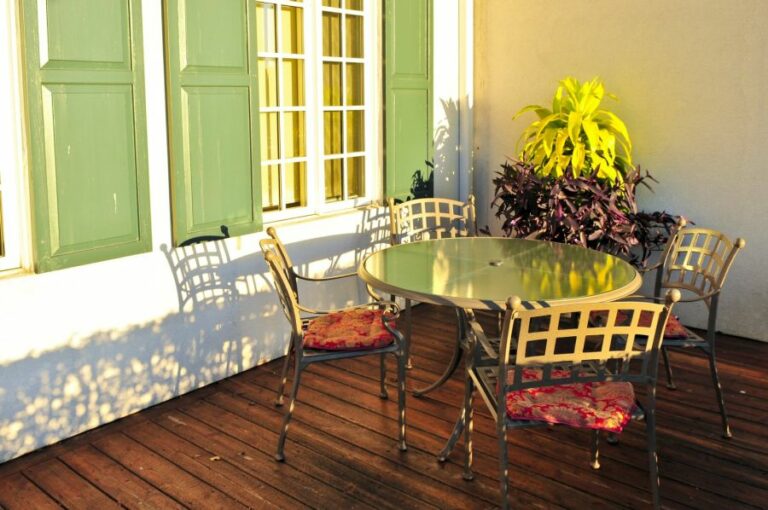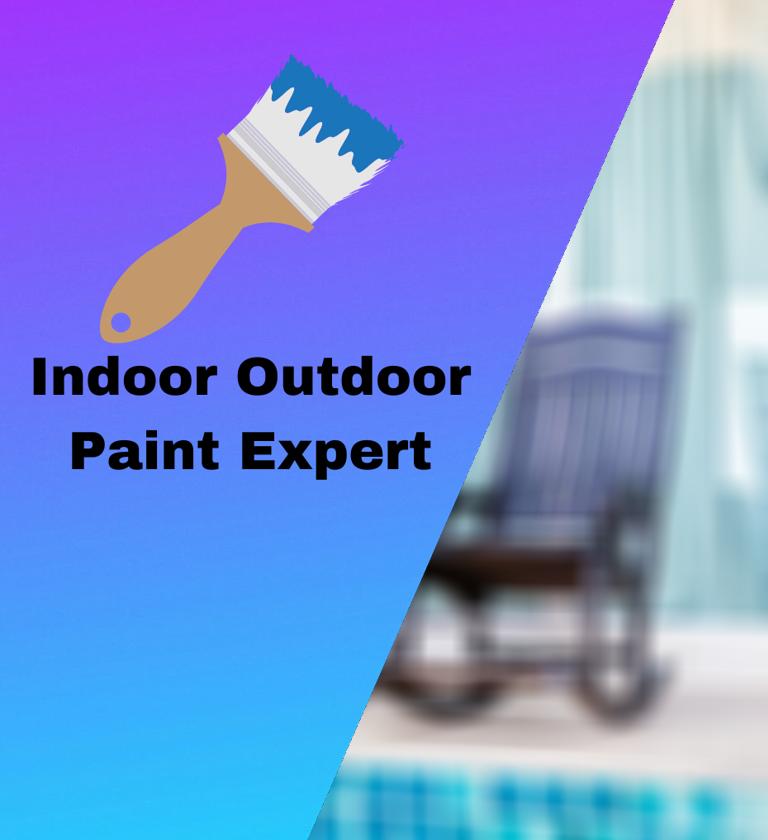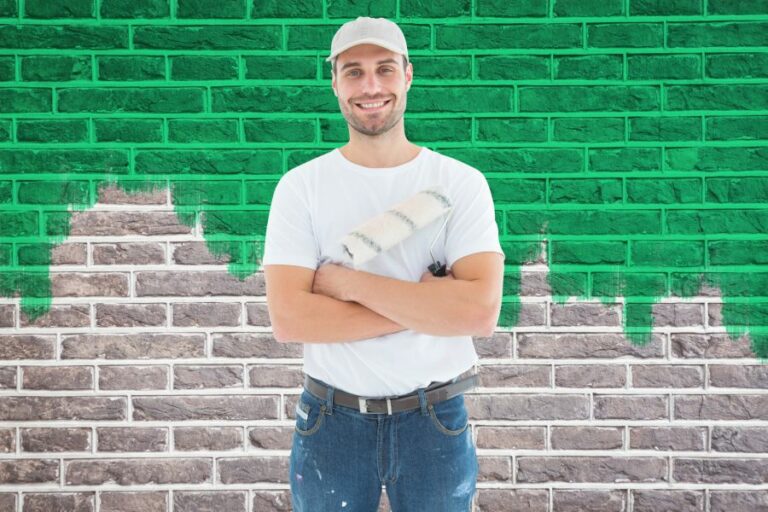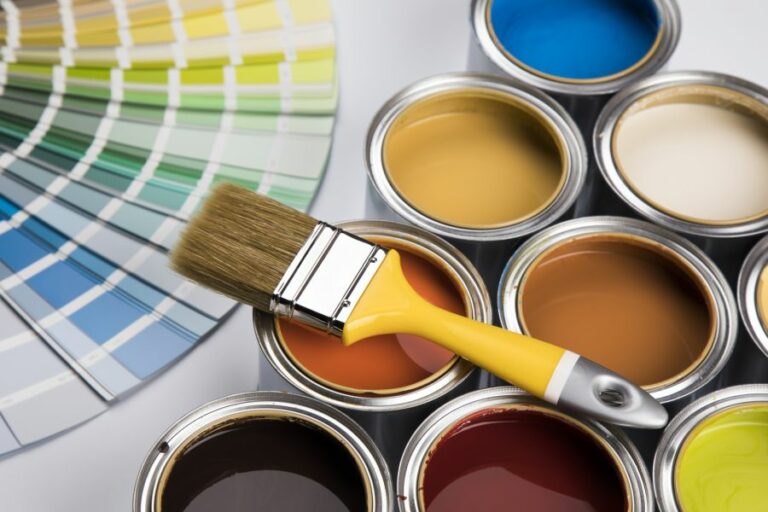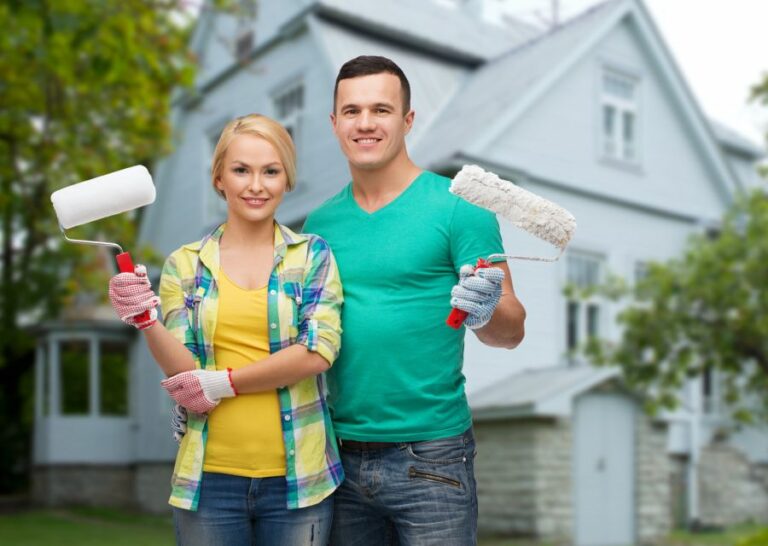Does Outdoor Paint Fade, 25 Things You Should Know
Have you ever looked at your freshly painted, vibrant exterior, only to find it weathered and dull a few years later? Many homeowners face this issue and wonder, does outdoor paint fade? Let’s delve into the causes of paint fading, the type of paint most susceptible to fading, and tips to ensure that your home’s paint job remains vibrant and fresh for years to come.
Does outdoor paint fade:
Exterior paint fading is an undeniable reality caused by ultraviolet rays, water and moisture intrusion, heat exposure, and airborne pollutants. Invest in high-quality, acrylic-based exterior paints to prolong the vibrancy of outdoor paint, prepare the surface thoroughly to ensure proper adhesion, incorporate shade structures to minimize UV exposure, and perform regular maintenance to prevent color degradation.

Discover the reasons behind outdoor paint’s vulnerability to fading and how factors like sunlight, weather, and paint type contribute to its deterioration. Master how to choose the right paint and preventive measures to prolong your paint job’s vibrancy and longevity.
Contents
- 1 Does Exterior Paint Experience Fading?
- 2 How Can You Prevent Outdoor Paint from Fading Over Time?
- 2.1 • Prelude: The Everlasting Struggle Against the Elements
- 2.2 • 1. Selecting the Ideal Paint: A Confluence of Quality and Technology
- 2.3 • 2. Harness the Potency of Colorfastness: A Palette of Enduring Hues
- 2.4 • 3. The Edict of Surface Preparation: A Labor of Dedication
- 2.5 • 4. Assiduous Application: A Litany of Layers & Technique
- 2.6 • Epilogue: A Covenant of Continuity & Care
- 3 Which type of exterior paint is resistant to fading?
- 4 Is Exterior Paint Prone to Fading Under Sun Exposure?
- 5 Which Exterior Paint Colors Tend to Fade?
Does Exterior Paint Experience Fading?
• An Overview: Pigmented Coating Longevity on External Surfaces
Painting serves as an indispensable aspect of home maintenance, providing not only aesthetic appeal but also protection against external elements. A recurrent concern among individuals embarking on an exterior paint project is the inescapable fading of outdoor paint.
Deterioration of colors on external surfaces is an undeniable reality, but understanding the factors and how to counteract them can prolong the vibrancy of outdoor paint. This guide aims to demystify the reasons, consequences, and ways to curb fading in exterior paint.
• The Underlying Culprits: Elements Influencing Outdoor Paint Fading
– Radiant Exposure: The Implication of Ultraviolet Rays
Sunlight appears innocuous, yet its ultraviolet (UV) rays have destructive ramifications on outdoor paint. UV radiation initiates molecular decomposition, causing the pigmented coatings to lose their inherent chromatic vitality.
These rays permeate the paint film, degrading its protective components and enabling erosion of the vividness it once possessed. Consequently, areas with frequent sun exposure are more susceptible to color deterioration and peeling.
– Hydric Assault: The Impact of Water and Moisture Intrusion
Water and moisture, in all forms, pose detrimental threats to outdoor paint. Torrential downpours, frost, and condensation can infiltrate the paint film, causing distortion in the structure and subsequent fading.
Furthermore, perpetual dampness accelerates degradation, as mold and mildew thrive in moist conditions, subsequently causing discoloration and fading.
– Prevalence of Heat: Destabilizing Pigmented Coatings
Prolonged high-temperature exposure detrimentally influences the integrity of outdoor paint, causing it to soften and lose adhesion. Heat exacerbates the fading process, as it hastens the evaporation of the paint’s volatile components, leaving a brittle residue that is prone to color deterioration.
– The Staining of Time: Airborne Pollutants and Weathering Agents
Contamination from pollutants in the atmosphere contributes significantly to the fading of exterior paint. Airborne substances such as dust, grime, and soot can accumulate on the painted surfaces, rendering the colors lackluster and dull.
Additionally, oxidizing agents in the atmosphere prompt chemical changes in the paint, leading to diminished vibrancy and eventual color loss.
• Countering the Onslaught: Methods to Preserve Outdoor Paint’s Vivacity
– Optimal Selection: Appropriate Pigmented Coating Types
Investing in high-quality paints formulated for exterior use ensures enhanced color retention and durability. These paints contain higher concentrations of pigments, binders, and UV-resistant agents, prolonging their resilience to fading.
Acrylic-based paints are preferable, as they provide superior adhesion, flexibility, and longevity compared to their oil-based counterparts.
– Prudent Preparations: Diligent Surface Conditioning
Preparing the surface thoroughly is paramount in improving paint adherence and preventing premature paint erosion. Remove existing paint, dust, and debris before applying the fresh coat, as these interfere with proper binding.
Additionally, ensure the surface is dry and devoid of any moisture, as dampness diminishes adhesion and promotes fading.
– Strategic Shading: Utilizing External Shielding Devices
Incorporating shade structures, such as awnings or pergolas, minimizes direct sun exposure on painted surfaces. These devices obstruct potent UV radiation while also providing a barrier against rain and moisture intrusion.
– Routine Maintenance: Exterior Paint Conservation Practices
Performing regular upkeep can mitigate the impending risks of exterior paint fading. Regularly cleaning painted surfaces with a mild detergent solution helps remove accumulated dirt and grime, restoring the color vibrancy.
Annual inspections for signs of paint deterioration, such as peeling or blistering, enable timely reparations, preventing further color degradation.
• Concluding Thoughts: Defying the Fade in Outdoor Paint
Inevitably, outdoor paint experiences fading, given the unrelenting stressors it endures. However, adopting the aforementioned practices may extend the longevity and hue-retention capabilities of your exterior paint, preserving the lustrous charm that shields your sanctuary.
How Can You Prevent Outdoor Paint from Fading Over Time?
• Prelude: The Everlasting Struggle Against the Elements
As a homeowner or property manager seeking to maintain the aesthetic appeal of your outdoor paint, you have surely grappled with the sagacious question: “How do you keep outdoor paint from fading?”
Fret not! In this compendium of wisdom, we delve into the prudent and efficacious methods for preserving your property’s visage against nature’s relentless onslaught.
• 1. Selecting the Ideal Paint: A Confluence of Quality and Technology
– Superior Ingredients Make for Lasting Colors
The inaugural step in our expedition is to select the preeminent paint for your home’s exterior. High-quality paints, with fortitude against fluctuating weather conditions and superior UV resistance, can be transformative in safeguarding your property from fading.
Ponder upon the immaculate fusion of premium ingredients, such as superior pigments and resins, that imbue the paint with the tenacity to face the elemental maelstrom.
– The Enchantment of Acrylic-based Formulations
Escalating the caliber further, consider utilizing acrylic-based formulations for their astonishing adhesion and inherent flexibility. These paragons of modern paint chemistry readily meld with diverse surfaces while adroitly enduring capricious temperatures, thus mitigating the insidious paint-peeling nemesis.
• 2. Harness the Potency of Colorfastness: A Palette of Enduring Hues
The realm of colorfastness alludes to the sublime art of retaining chromatic vibrancy, a cornerstone of arresting paint longevity. Embrace the stylish and robust hues conferred by paints with remarkable colorfast properties.
With meticulous deliberation of the property’s exterior, one can unveil the elusive balance of a visually stunning and enduring color scheme.
• 3. The Edict of Surface Preparation: A Labor of Dedication
– The Crucible of Cleaning and Scouring
Journey through the indispensable phase of surface preparation, for it forms the cornerstone of your paint’s lasting success. Abnegate any notion of shortcuts, as a thoroughly cleaned and scoured surface shall reward you with exemplary paint adhesion.
Be ever-vigilant in banishing grime or mildew with the sacred trinity of water, detergent, and diligent scrubbing. Succeed in this, and your paint’s foundation will be formidable.
– An Ode to Sanding and Priming
Silver-tongued sanding, you are the unsung hero of our tale. The subtle art of sanding revivifies surfaces and fosters the harmonious union of primer and surface.
Let your primer be appointed the role of guardian, sealing the surface and bridging the path to a transcendent paint application experience. Indeed, a surface thus meticulously prepared shall rebuff the sinister specter of fading.
• 4. Assiduous Application: A Litany of Layers & Technique
– Eschew Impatience: The Value of Double Coats
In the subsequent boon of applying the sanctified paint, heed the axiom of layers. A solitary coating may suffice for but a fleeting victory against fading; a double coat, however, inaugurates a steadfast alliance with durability.
For paintings worth their salt, two layers shan’t be perceived as excessive but as the prevailing norm.
– Precision in Technique: A Brush with Perfection
For those who seek the bulwark of fortitude against fading, artistically wield your brush or roller with surgical precision. By ensuring uniform coverage, without unsightly drips or grainy inconsistencies, your paint shall possess a lustrous and enduring countenance.
Allow yourself to be a maestro with your tools, and your artistry shall vanquish the fading foe.
• Epilogue: A Covenant of Continuity & Care
Paint, you have traversed many a threshold, surmounting the barriers of quality, colorfastness, and fastidious preparation. Yet, to retain your radiant and unwavering presence, a covenant of continuity must be struck.
Commit to the vigilant inspection and timely maintenance of your property’s exterior. In doing so, allow yourself to indulge in the resplendent finish you have so diligently created.
The sun shall rise, the tempests shall howl, yet your outdoor paint, with its perplexing intricacy and prolific diversity, shall stand steadfast as a testament to your unyielding perseverance.
Step | Description |
|---|---|
Choose high-quality paint | Select a paint that is specifically designed for outdoor use and has UV protection and fade-resistant properties to ensure long-lasting color. |
Apply a primer | Before painting, apply a high-quality primer to the surface to create a stronger bond between the paint and the surface, which helps prevent fading and peeling. |
Use the right technique | Apply paint in thin, even coats to ensure full coverage and protection from the sun’s UV rays. Use a brush, roller, or sprayer that is appropriate for the surface being painted. |
Maintain surface cleanliness | Regularly clean the painted surface to prevent dirt and grime from building up, which can lead to fading and discoloration over time. |
Touch up as needed | periodically check the paint for signs of fading or wear, and touch up any areas that need it to keep the paint looking fresh and vibrant. |
Consider adding a protective coating | If your paint is prone to fading, consider applying a clear protective coating over the paint. This will add an extra layer of protection against the sun’s UV rays and other elements that can cause fading. |
Which type of exterior paint is resistant to fading?
Immaculate exteriors, alluring hues, and longevity are the trinity of a property owner’s dream. When it comes to home makeovers, one precipitates into an ocean of paint brands and technology.
To finally fathom which products deliver resplendent shades that stand the test of time, let’s begin our quest for longevity in exterior paints.
• The Alchemy of Persistence: High-Quality Ingredients
Durable, fade-resistant coating material springs from the fusion of superior ingredients. The nexus of paint formulae revolves around high-quality resins, premium pigments, and exceptional additives that engender antifungal and UV-blocking properties.
– Resins: The Elixir of Adhesion & Longevity
Resins serve as the backbone of a paint’s composition. Superior resins encapsulate pigments, melding seamlessly onto exteriors, safeguarding them from peeling, cracking, and the relentless onslaught of time.
Acrylic Resins: The Pinnacle of Endurance:
Renowned for their superlative durability and flexibility, acrylic resins excel at tolerating climatic fluctuations. They defy exterior degradation and shine unblemished over time.
Alkyd Resins: The Adept Contender
Traditionally employed for their ease-of-use and superb gliding action, alkyd resins bask in splendid gloss retention. However, they’ve steadily ceded ground to their acrylic counterparts due to the latter’s unmatched UV resistance.
– Pigments: The Kaleidoscope of Radiant Colors
Stellar pigments impart enrapturing brilliance to home exteriors. Their innate ability to resist fading under sunlight and acquire a tasteful patina over time dictates a paint’s imperishability.
Inorganic Pigments: The Epoch of Colorfastness
Clay-based minerals and metallic oxides underpin these stalwart pigments. They exhibit a scintillating resistance to solar degradation and bestow exteriors with unyielding chromatic splendor.
Organic Pigments: The Vanguard of Intensity & Opacity
Heralded as the paragons of vibrancy and depth, these carbon-based compounds often struggle to conquer their Achilles heel: the susceptibility to UV-induced fading. Nonetheless, their state-of-the-art iterations show remarkable, alacritous improvements in solar resilience.
– Additives: The Sorcery of Support & Enhancement
The enchantment of fade-resistant paint relies on an auxiliary entourage of additives. These sophisticated elements possess antifungal, anti-mildew, and UV-blocking attributes that nurture the longevity of exterior paint.
• The Best Exterior Paint Brands: The Champions of Invincibility
Now, let’s delve into the top-tier exterior paint brands known for their unrivaled, fade-resistant performance.
– Sherwin-Williams Duration: An Ode to Permanence
Boasting cutting-edge acrylic technology, this paint line triumphantly showcases remarkable durability, breathability, and steadfast colors. Its proprietary “PermaLast” system furnishes permanent, unyielding protection.
– Benjamin Moore Aura: The Pantheon of Elegance
Esteemed for its tenacious adherence, mesmerizing color depth, and aegis against fading, Aura promises sublime aesthetics and high performance. Its ingenious “Color Lock” technology safeguards and enchants.
– Behr Marquee: The Dynasty of Opulence
Engineered explicitly for stately exteriors, Behr Marquee guarantees a richly-textured, single-coat application with striking color continuity. An imbued concoction of UV-resistant polymers and mildewcides imparts enduring beauty.
– PPG Timeless: The Chronology of Protection
A paragon of ultraviolet shielding, water repellency, and sublime pigmentation: Timeless resolutely combats gradual fading. This paint’s “Automotive-grade” polymers champion a perpetual, unblemished appearance.
Ultimately, the secret to arresting, fade-resistant exterior paint resides in the triumvirate of high-quality resins, pigments, and additives. Contemporary exterior paint brands invest their prowess in the synthesis of cutting-edge technology with time-tested wisdom, yielding stunning and timeless results.
By making an investment in brands like Sherwin-Williams Duration, Benjamin Moore Aura, Behr Marquee, or PPG Timeless, you guarantee the lasting beauty and protection of your home’s facade, allowing it to flourish in a resplendent array of colors that stand unwavering against the test of time.
Is Exterior Paint Prone to Fading Under Sun Exposure?
A seemingly endless panorama of residential and commercial properties is festooned with variegated, dazzling exterior paint hues.
While these palettes imbue a distinct personality to the structures, many wonder about the sunlight’s adverse repercussions on the colors’ vitality. This composition elucidates the root causes, preventative measures, and rectification methodologies for the eventuality of sun-driven exterior paint deterioration.
• The Pernicious Solar Menace
The omnipresent sun is undeniably integral to our planet’s sustenance. However, this celestial orb is also a malefactor that wreaks havoc on exterior paint through its incessant assault of solar radiation.
The photodegradation process debilitates the pigment’s molecular structure, culminating in a lackluster and feeble semblance. Fortuitously, certain lacquer classifications and compositions better withstand the sun’s barrage, as explicated later.
– Chromatics and Ultraviolet Invasion
Chromatic hues are dichotomized into two categories: organic and inorganic. While the former exhibits vibrancy and depth, the latter is renowned for its steadfast resilience to ultraviolet (UV) entrenchment.
Concomitantly, it is important to comprehend that the precise shade, such as vivid reds, can be more vulnerable to fading as opposed to subdued hues like muted grays.
– Equatorial Exacerbation
Incidentally, properties situated closer to the equator receive the brunt of solar radiation. The intensity in these areas unequivocally accelerates the depletion of exterior paint, leading to a truncated lifespan of the once-vibrant hue.
Conversely, the farther one is situated from the equator, the slower the fading process will be.
• Fortification through Innovation
– State-of-the-Art UV-Defiant Compositions
Modern paint manufacturers have made prodigious strides in creating novel formulas that manifest enhanced UV resistance.
Many varieties of top-tier exterior paint now integrate an amalgamation of specialized additives and resins that work in concert to bolster the coating’s durability vis-a-vis the perils of sunlight. Homeowners and contractors should judiciously opt for these cutting-edge concoctions for superior solar shielding.
– Implementing a Superior Sheen
Glossier exterior paints have captivated aestheticians and practical homeowners alike. A high-sheen finish endows a formidable barrier that rebuffs UV penetration, thus preserving the underlying color’s integrity.
Furthermore, gloss finishes harbor an innate condensation-repelling faculty, which obviates moisture ingress and subsequent blight.
– The Allure of Inorganic Tonality
As aforementioned, inorganically-sourced pigments exhibit commendable steadfastness against sun-induced fading. Those who reside under an incessant solar onslaught can wield this tidbit of knowledge when selecting a hue for their domicile.
Shades that lean toward earthy or muted palettes are ideal candidates for a persistent exterior facade.
• Amelioration and Renovation
In the event that sun-induced fading has already exacted a toll on a building’s exterior paint, there are several remedial measures one can consider. A vigorous and meticulous cleaning can expunge accumulated detritus, which oftentimes restores a modicum of the color’s original luminosity.
Furthermore, comprehensive sanding and repainting should be considered with the employment of the aforementioned UV-resistant paints and appropriate sheens.
In summary, the sun’s bombardment of UV rays has the capacity to attenuate exterior paint’s vibrancy and longevity. Although fading is inescapable, homeowners and contractors can preemptively thwart sun-driven degradation through informed paint selection and implementation.
By adopting cutting-edge formulations, glossy finishes, and inorganic pigments, one’s edifice will emanate chromatic splendor for years to come.
Which Exterior Paint Colors Tend to Fade?
Paint color fading is a common concern for homeowners when selecting the perfect hue for their home’s exterior. What factors contribute to the rate at which colors fade, and which paint shades are more prone to deterioration?
• The Science Behind Fading: A Symbiosis of Elements
To discern which paint colors are more likely to fade, we must first examine the interplay between various factors that hasten the fading process, such as:
– Ultraviolet Rays
Sunlight’s pernicious ultraviolet (UV) rays contribute significantly to paint color deterioration. These light wavelengths cleave the bonds within paint pigments, causing the vividness of the hues to wane. The cardinal rule is the more ostentatious the color, the more susceptible it is to UV degradation.
– Ambient Temperature Fluctuations
Dramatic climatic variances play a vital role in inducing paint color to fade. Expansion and contraction due to fluctuating temperatures lead to paint layer cracking, rendering the colors less pronounced.
– Moisture Infusion
Vicissitudes of water, particularly in regions with high precipitation, accelerate the fading process. Moisture infiltration can result in paint peeling, erosive efflorescence, and increased microorganism growth, leading to a dull, muted appearance.
• Vulnerable Hues: The Fade-Prone Spectrum
Now that we comprehend the elements responsible for paint color fading, we can draw insights into specific hues within the chromatic spectrum that present an elevated risk of fading.
– Inky and Sombre Blues
Dark and moody blues, such as indigo or navy, are particularly susceptible to fading. The depth and richness of these shades absorb more sunlight and heat, thereby increasing their rate of UV-induced decomposition.
– Empyrean Reds and Oranges
Inexorable and bold reds and oranges tend to exhibit a significant degree of fading. These eye-catching zenithal hues have larger pigment molecules that are more exposed to UV light, augmenting their vulnerability to fading.
– Verdant Greens: Nature’s Paradox
A forest or emerald green paint color may seem like an earthy, natural choice for a home’s exterior, but these verdant shades are also prone to fading. The high concentration of organic pigments in these colors makes them attractive targets for UV light.
• An Ode to Longevity: Fade-Resistant Paint Colors
To curate a viscerally evocative and tenacious color palette for your home’s facade, consider selecting from the spectrum of shades that offer increased resistance to fading:
– Taupe and Beige: The Charm of Subtlety
These neutral, unpretentious hues are renowned for their ability to resist fading. The smaller pigment molecules in these colors render them more impervious to the deleterious effects of sunlight.
– Immaculate Whites
A classic choice for many homes, white paint does an exceptional job of reflecting sunlight and withholding its lustrous complexion over time. Whites also offer the added advantage of camouflaging minor imperfections.
– Greys: Elegant and Enduring
An array of greys, ranging from light to charcoal, imparts a sophisticated allure while offering the durability necessitated by fluctuating temperatures and UV exposure.
• A Prudent Approach: Quality and Technique
When considering which exterior paint color to choose, selecting a hue with an innate resilience to fading is only half the battle. Ensuring that your selected color maintains its vibrancy hinges upon investing in high-quality paint and adhering to best-practice painting techniques:
- Opt for premium-grade paints that contain higher levels of pigments, binders, and additives.
- Consider the use of a UV-resistant paint or sealer to provide added protection against sunlight.
- Employ professional painting techniques to produce an even, uniform finish that will withstand the test of time.
In conclusion, while certain exterior paint colors may be predisposed to fading, informed color selection and adherence to proper painting protocols can ensure your home’s exterior retains its allure for years. Arm yourself with this knowledge, and paint your home with confidence.

